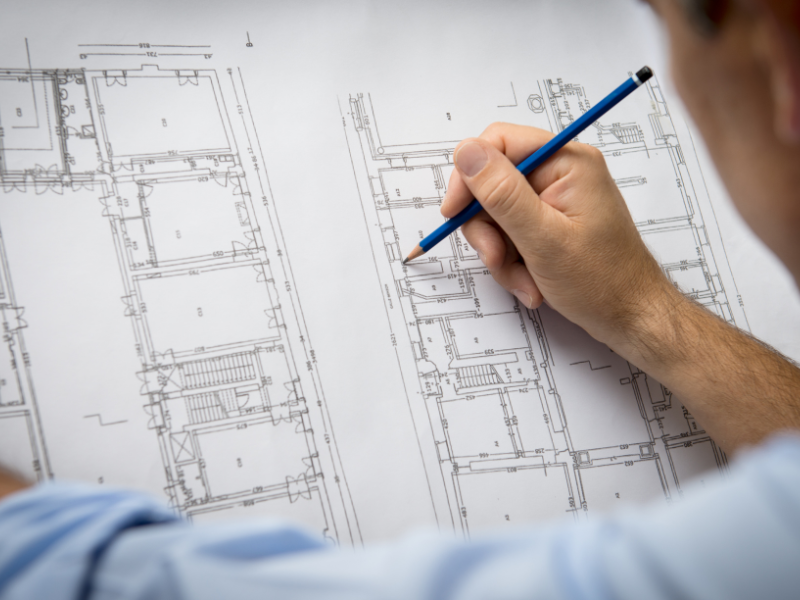Comprehending the Diverse Occupation Paths Available for Aspiring Architect
As a hopeful Architect, you have a globe of career paths waiting for you. Each path provides special challenges and chances to apply your imagination and technological knowledge. Whether you're drawn to traditional design or the nuances of sustainable design, there's a specific niche that lines up with your rate of interests. Comprehending these diverse options can shape your professional trip, yet which instructions will you select to check out first?
Standard Architecture: Designing Frameworks and buildings
Standard design concentrates on creating structures and structures that mix functionality with aesthetic appeal. Your designs can mirror cultural heritage, showcasing local traditions while fulfilling modern requirements.
You'll develop abilities in drafting, model-making, and website evaluation, permitting you to imagine and connect your ideas successfully. Involving with customers, you'll require to understand their vision and equate it right into viable designs.
Furthermore, constructing codes and sustainability techniques are important in your job, guaranteeing your structures are eco pleasant and secure. As you expand in your career, you'll discover possibilities in domestic, industrial, or also reconstruction projects, each offering distinct difficulties. Accepting traditional architecture paves the way for a meeting career that admires the past while shaping the future.
Urban Planning: Forming Areas and Public Spaces
As an ambitious Architect, you can play an important role as a metropolitan coordinator, transforming exactly how areas communicate and function. By utilizing community engagement approaches, you'll ensure that citizens have a voice fit their environment. Plus, integrating lasting layout concepts will certainly assist produce spaces that not just satisfy today's requirements but also protect the future.
Duty of Urban Planners
While numerous could think of designers as the single visionaries behind structures, urban coordinators play an essential function in shaping the more comprehensive landscape of communities and public spaces. By working together with different stakeholders, you'll aid design parks, transportation systems, and property areas that promote social interaction and access. Your knowledge in spatial design and area characteristics permits you to imagine future growth while protecting cultural heritage.
Neighborhood Interaction Techniques
Efficient neighborhood involvement strategies are vital for urban planners to assure that the voices of residents are listened to and valued in the preparation procedure. To promote meaningful discussion, you must prioritize open forums and workshops where community members can share their concepts and worries. Use surveys and social networks to reach a more comprehensive target market, ensuring varied point of views are included. Collaborating with neighborhood companies can boost depend on and promote much deeper connections. It is very important to provide clear information about suggested projects and decision-making procedures, permitting citizens to feel informed and encouraged. By actively integrating and listening responses, you'll create rooms that show the community's demands, eventually leading to even more sustainable and successful city atmospheres. Welcome transparency and continuous dialogue for lasting influence.
Sustainable Design Concepts
When making city spaces, including sustainable design principles is crucial for creating atmospheres that prosper both environmentally and socially. You need to begin by concentrating on power performance, utilizing products that decrease waste and advertise recycling. Consider integrating green rooms, like gardens and parks, to enhance biodiversity and improve air quality. Promoting walkability and public transport can minimize reliance on vehicles, cultivating a healthier community.
Designing with water conservation in mind is also vital-- consider rainfall gardens and absorptive surfaces to manage stormwater. Entailing neighborhood members throughout the preparation process assurances that the spaces you develop meet their demands and urge social interaction. By embracing these concepts, you'll add to vibrant, sustainable urban landscapes that profit everyone.

Landscape Architecture: Developing Sustainable Exterior Environments
As you check out landscape style, you'll find necessary style principles that create beautiful and practical exterior rooms. Sustainable methods play a vital role in guaranteeing these settings grow while reducing environmental impact. And also, you'll find a selection of career opportunities that permit you to make a real difference in how people interact with nature.
Design Principles in Landscape
Comprehending layout concepts in landscape architecture is necessary for developing lasting exterior settings that harmonize with nature. You'll require to ponder components like percentage, range, and equilibrium to guarantee your designs feel natural and welcoming. Including indigenous plants not only improves biodiversity but also reduces water use, making your landscape durable. Think regarding the circulation of room and how individuals connect with it; pathways and seating areas ought to invite expedition and leisure. Furthermore, pay focus to seasonal adjustments, making with materials that complement the environments year-round (Architect). By prioritizing sustainability and appearances, you can develop outside rooms that enhance the community and advertise wellness. Welcoming these concepts will certainly set a strong structure for your career in landscape style.
Sustainable Practices Introduction
Sustainable techniques in landscape style not just focus on aesthetics however also prioritize environmental wellness and resource conservation. By integrating native plants, you improve biodiversity and minimize the demand for chemical fertilizers site link and pesticides. Implementing effective watering systems assists preserve water and decreases overflow, protecting nearby communities. You can develop areas that promote soil health and wellness, such as making use of natural materials and practicing permaculture concepts. Additionally, incorporating green facilities, like rainfall yards and porous pavements, aids in stormwater monitoring and reduces urban heat. When you create outdoor settings with sustainability in mind, you add to a much healthier world and supply rooms that foster community link. Inevitably, these methods assure your layouts benefit both people and the setting for many years ahead.
Profession Opportunities Expedition
With a strong structure in sustainable techniques, landscape architecture uses a variety of job courses that enable you to make a meaningful effect on the environment. You might function as a landscape designer, creating cosmetically pleasing and functional exterior areas, or concentrate on ecological repair, assisting to revive broken ecosystems. Urban coordinators usually team up with landscape architects to produce eco-friendly areas in urban settings, boosting city livability. If you're passionate concerning education, consider ending up being a landscape architecture educator, motivating future generations. In addition, you might deal with nonprofits focused on environmental sustainability or participate in study to introduce new methods. Each course not only shapes stunning settings yet likewise promotes a much healthier earth for future generations.
Sustainable Layout: Focusing on Eco-Friendly Practices
As you explore your occupation in design, welcoming green practices can set you apart in a competitive area. Sustainable style concentrates on producing structures that reduce environmental influence while improving passenger wellness. By integrating renewable products, energy-efficient systems, and sustainable building techniques, you'll contribute to a greener future.
Start by acquiring expertise of green accreditations like LEED or BREEAM, which can boost your qualifications. Think about how natural light, ventilation, and thermal efficiency can enhance design. Collaborate with engineers and environmental experts to innovate services that lower waste and save sources.
Don't fail to remember the value of community participation-- interesting local stakeholders can influence styles that balance with the setting. As clients progressively focus on sustainability, your expertise in green practices will certainly not only attract projects however additionally meet your interest for accountable design. Welcome this important aspect of the occupation, and enjoy your profession thrive.
Historic Conservation: Safeguarding and Recovering Cultural Heritage
While you commence on your architectural trip, think about the vital duty of historical conservation in maintaining our social heritage. This area focuses on the security and remediation of substantial structures, websites, and frameworks that inform the stories of our past. By participating in historic conservation, you'll aid guard the building legacy that shapes community identification.
As a historic preservation Architect, you'll evaluate historical relevance and evaluate the problem of frameworks. You'll function carefully with preservationists and historians to guarantee authentic remediation strategies are employed. This job course allows you to mix creativity with research study, allowing you to make solutions that value original materials and craftsmanship.
Your job not just contributes to sustainability by reusing existing buildings yet also promotes a feeling of satisfaction within areas. Embracing this path will help you end up being a guardian of history, preserving the tales and visual appeals that improve our lives.
Interior Design: Enhancing Indoor Spaces
Historical preservation and indoor style both share a dedication to enhancing the constructed setting, however they concentrate on various aspects. While historical preservation highlights keeping a structure's historical and social worth, interior design nos in on maximizing indoor spaces for functionality and visual appeals.
As an aspiring Architect, you'll discover that interior style permits you to blend creative thinking with technological skills. You'll make areas that not have a peek at this website just look excellent but also promote convenience and effectiveness. This field involves recognizing exactly how light, shade, and materials interact within an area, affecting state of mind and usability.
You'll deal with various projects, from property homes to industrial offices, making sure that each environment meets the demands of its passengers. By prioritizing user experience, you can change interiors into useful and motivating spaces, making a substantial effect on just how individuals communicate with their surroundings. Welcome the possibility to improve indoor settings and form the method people live and function.
Industrial Style: Combining Performance With Aesthetic Appeals
Commercial style plays an important function in creating products that flawlessly mix visual appeals with performance, ensuring that what you make use of day-to-day is not just aesthetically enticing but likewise useful. As an ambitious Architect, you could immerse yourself in this field, concentrating on making everything from furnishings to consumer electronic devices. Your work involves recognizing individual demands, materials, and producing processes, enabling you to develop innovative services that improve day-to-day experiences.
In commercial style, you'll often collaborate with manufacturers, engineers, and marketing experts, making certain that your designs are not just attractive yet additionally practical. This occupation path supplies a vibrant environment where creativity meets functionality, making it a gratifying option for engineers interested in shaping the products of look at this website tomorrow.
Regularly Asked Concerns
What Educational Certifications Do I Need to Come To Be a Designer?
To end up being an architect, you'll need a specialist degree in architecture, usually a Bachelor's or Master's. Additionally, you'll need to complete a teaching fellowship and pass the Architect Enrollment Assessment to exercise legitimately.
Exist Qualification Requirements for Different Architectural Job Paths?
Yes, there're qualification needs for different building courses. Architect. You'll require to pass tests, complete internships, and in some cases go after specialized training, depending on your selected focus, like landscape style, urban design, or historical preservation
What Software Program Abilities Are Crucial for Designers Today?

Just How Can I Gain Practical Experience While Examining Design?
You can obtain sensible experience by interning at building companies, getting involved in layout competitors, offering for area jobs, or teaming up with schoolmates on real-world jobs. These chances improve your skills and develop useful connections in the market.
What Task Opportunities Exist Outside Conventional Architecture Firms?
You can discover various task chances outside standard architecture firms, like urban preparation, interior style, landscape design, construction administration, genuine estate advancement, and even duties in sustainability consulting. Each offers unique challenges and incentives.
Whether you're attracted to traditional design or the nuances of lasting design, there's a niche that straightens with your interests.When creating city spaces, incorporating lasting layout concepts is essential for developing atmospheres that prosper both environmentally and socially.As you check out landscape design, you'll discover essential design principles that develop beautiful and useful outdoor spaces.Comprehending design concepts in landscape style is important for producing lasting exterior settings that harmonize with nature.In commercial style, you'll typically collaborate with engineers, marketing experts, and suppliers, making sure that your designs are not only lovely yet additionally feasible.
Comments on “Architect Advice on Maximizing Compact Urban Spaces”